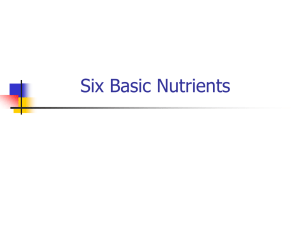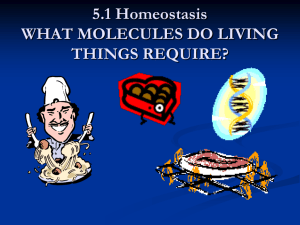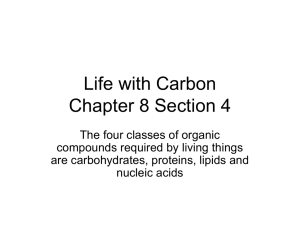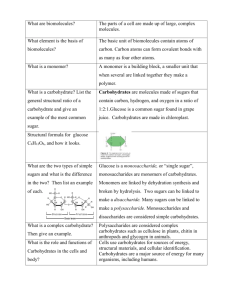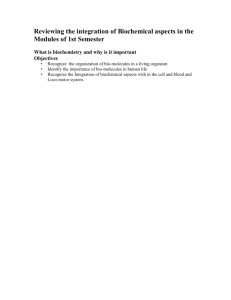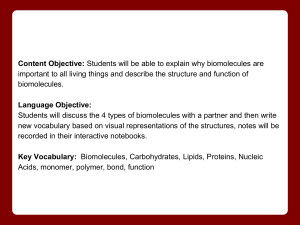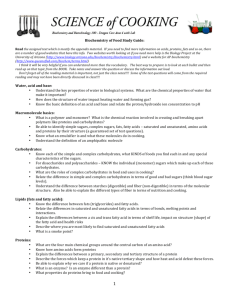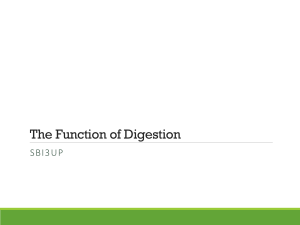5. The Chemistry of Life
advertisement
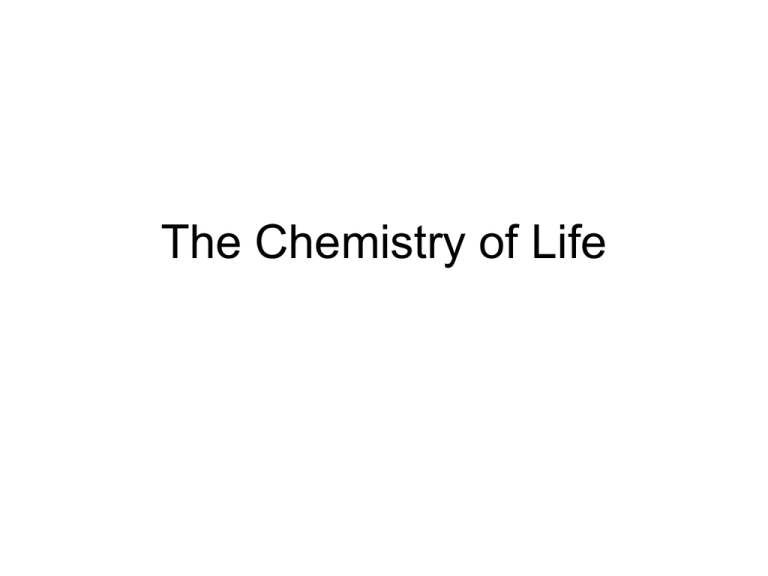
The Chemistry of Life The Chemistry of Life • It has been estimated that over 200,000 chemical reactions occur in the cells of our body. All of these chemical reactions are referred to as our metabolism. Metabolic reactions can be either: a) Catabolic – materials are broken down Or b)Anabolic – materials are built • Organic chemistry is the area of chemistry that refers to compounds containing carbon. All living things are organic. Organic compounds can be broken down within cells for energy or linked together to form long chains necessary for life. • Living things are composed of non-living chemicals. Proteins, carbohydrates, lipids (fats), nucleic acids, vitamins, and minerals are all chemicals of living things. All of the macromolecules (big molecules) are mostly made up of carbon, hydrogen, oxygen, and sometimes nitrogen. The bulk of what we eat is made up of carbohydrates, proteins, and fats. Vitamins and minerals are also required, but in much smaller amounts. 1) Carbohydrates • Carbohydrates are the body’s most important source of energy!! The human body is not capable of making these vital chemicals by itself and must rely on plant sources for this important nutrient. What are Carbohydrates? • Carbohydrates are sugars or starches and have an –ose ending. These are chains of sugar molecules joined end to end like cars of a train. Cellulose is a polysaccharide found in plants. Animals are not able to digest and absorb this starch and it travels through the digestive system relatively unchanged. We call this fiber. •There are 3 different forms these chains can be found in: • a) Monosaccharidescontain only one sugar in the chain (glucose) • b) Disaccharides- contain only two sugars in the chain (sucrose) • c) Polysaccharides – many sugars in the chain (starch) • Animals store carbohydrates in the tissues in the form of glycogen. The sugars from the foods we eat gets either gets used up as fuel for the cells or stored for future use. This stored sugar (glycogen) is stored for a short time, minutes or hours. If it is not used up, it will be converted into long term storage as fat in adipose (fat) cells. 2) Proteins • Proteins are the structural component of cells. They are present in mitochondria, ribosomes, muscles, skin, antibodies, enzymes, etc… Proteins are essential for the building, repair and maintenance of cell structure. They are composed of 20 different amino acid building blocks. • Proteins are essential to our diet. There are 8 amino acids that the body cannot synthesize called essential amino acids. These must be obtained from your food. 3) Lipids • Lipids are also known as fats (solids at room temperature) or oils (liquid at room temperature). Lipids are compounds which are insoluble (do not dissolve) in water. Fats are concentrated packages of energy containing more than twice as much energy as the same amount of carbohydrates. Function of Lipids a) as energy storage – glycogen builds up resulting in conversion to long-term storage molecule: fat b) makes up cell membranes - phospholipids c) cushion for organs d) carrier and storage for vitamins 4) Nucleic Acids Nucleic acids are the hereditary material found inside the chromatin in the nucleus. DNA (deoxyribonucleic acid) is made up of this type of nutrient. Nucleic acids are nitrogen-containing compounds and are composed of nucleotides. Just like amino acids are the building blocks of proteins, nucleotides are the building blocks of nucleic acids. You are what you eat…. • When we consume food, we are eating the DNA from a variety of sources. Our digestive system cuts apart the nucleotides from the foreign DNA. These single nucleotides (which are the same as in human DNA) are used to make new DNA for our new cells that are always under construction. So, you REALLY “are what you eat!” 5) Vitamins and Minerals • Vitamins and minerals are required in only small amounts and help in chemical reactions in the body. Vitamins and minerals are essential for good health. Vitamins and minerals boost the immune system; support normal growth and development, and help cells and organs do their jobs. Rickets • Most cases of rickets are caused by a lack of vitamin D. Vitamin D helps the bones absorb calcium and phosphorus from food. When your child does not get enough vitamin D, his or her bones do not get those necessary nutrients that makes bones strong. Osteoporosis • Osteoporosis is a loss in bone density due to a prolonged deficiency of calcium.

